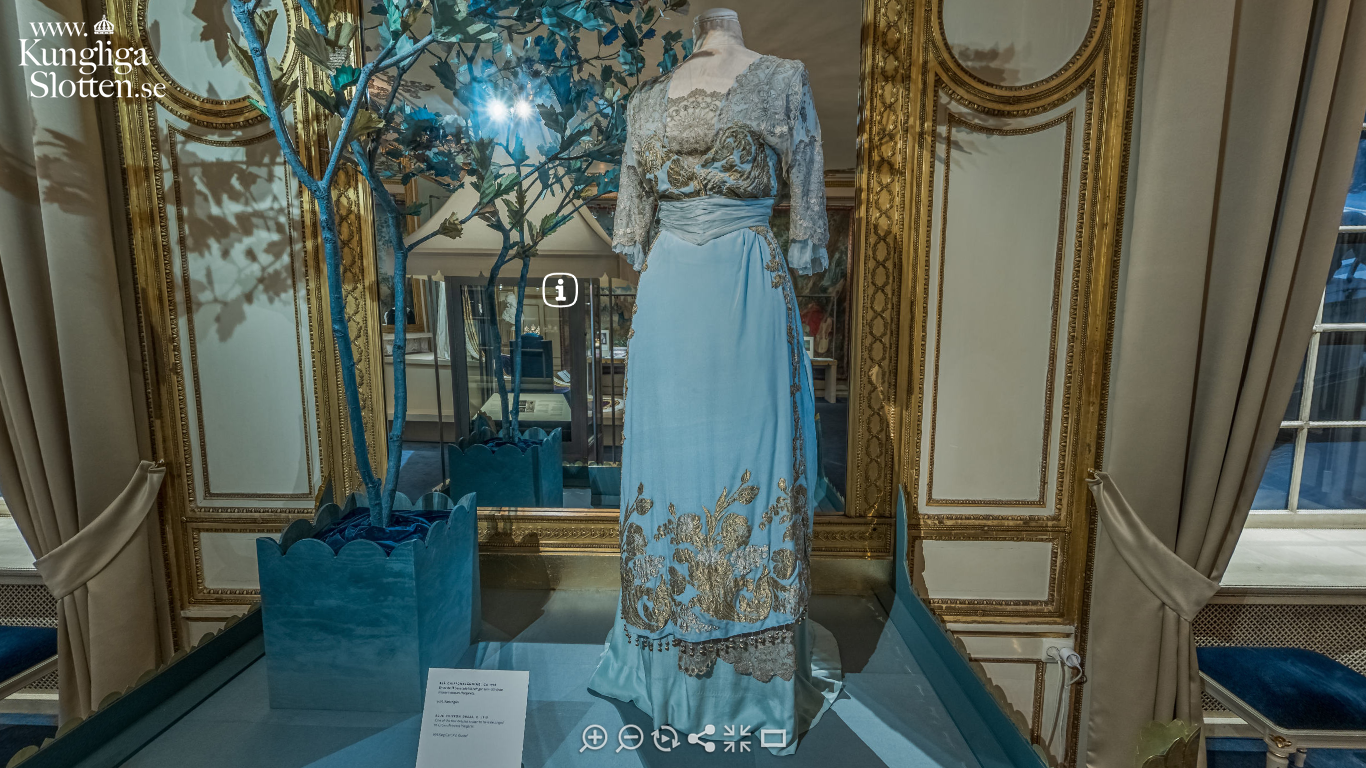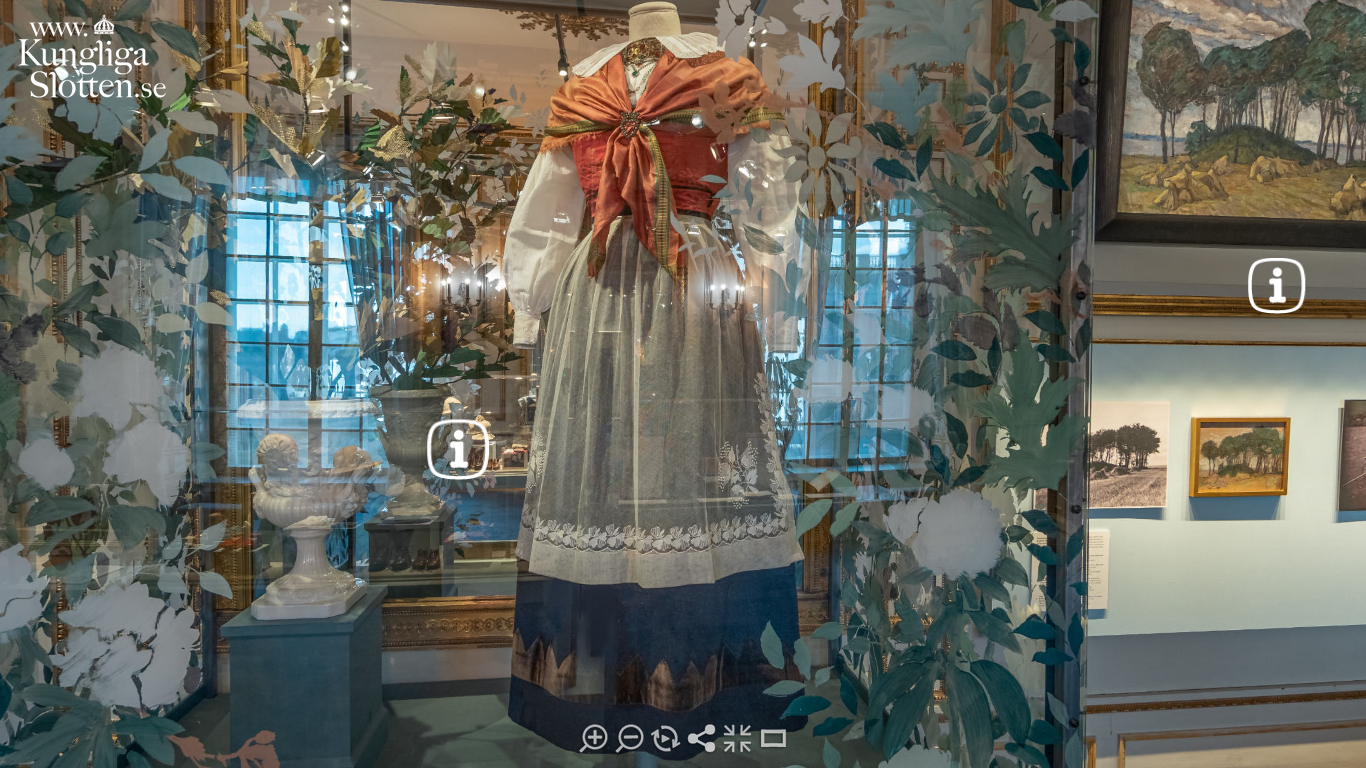

Princess Margaret of Connaught (1882-1920), known affectionately as “Daisy” to family and friends, was the oldest child of Prince Arthur, Duke of Connaught and Strathearn (1850-1942), third son of Queen Victoria (1819-1901), and his wife, Princess Louise Margaret of Prussia (1860-1917). In 1905, she married Prince Gustaf Adolf of Sweden (1882-1973) after a whirlwind courtship that began when they met in Egypt, becoming Duchess of Scania. Upon the accession of her father-in-law, King Gustaf V (1858-1950), to the Swedish throne in 1907, she became Crown Princess of Sweden. Crown Princess Margareta settled happily into her new life in her adopted country: she involved herself in charitable causes, painted, photographed, played sports and enjoyed gardening. A devoted mother to her five children, she was pregnant with her sixth child when she died suddenly at the young age of thirty-eight. In 1923, her widower married Lady Louise Mountbatten (1889-1965), who became queen consort when he succeeded his father as King of Sweden in 1950.

Crown Princess Margareta is a sort of forgotten royal, whose clothes, few of which have survived, usually do not see the light of day. No amount of searching on the Internet will yield a photograph of an extant garment that once belonged to her. So, the exhibition Daisy. Crown Princess Margareta, 1882-1920, which took place from June 6, 2021 to January 9, 2022 at the Royal Palace in Stockholm but is now available to view online, offered the very rare opportunity to see her outfits up close. It also featured portraits of the Crown Princess—Georgina Koberwein-Terrell’s (1853-1903) copy of Heinrich von Angeli’s (1840-1925) painting of the sitter when she was seventeen (see figures 1.1 and 1.2), two full-length works depicting her in evening dress by Axel Jungstedt (1859-1933) and Oscar Björck (1860-1929) and a fourth, also by Björck, showing her attired in fashionable daywear of the late 1900s (figure 1.3).

Crown Princess Margareta’s rooms in the Royal Palace in Stockholm served as a venue for the exhibition, which included objects and mementoes that give an intimate glimpse of her life and interests. The items ranged from the poignant—Margareta’s last painting, which she completed a few weeks before her death, was one of the exhibits—to the grand and extremely valuable, such as the ruby tiara she received as a wedding present from her uncle King Edward VII of the United Kingdom (1841-1910) and his consort, Queen Alexandra (1844-1925). The clothes and accessories in the display comprised a small slice of her wardrobe and that of her five young children.
For the purposes of this post, I have chosen to focus on those garments that were once worn by the Crown Princess. Although few in number, they are varied in terms of function.


An example of the Crown Princess’s outerwear can be found in a simple dolman-style jacket in white wool, rendered sumptuous thanks to embellishments with gold-embroidered floral motifs such as the Tudor rose, a symbol of England (figure 1.4). Such a garment would have served to remind others that the wearer was a British princess.

The only non-ceremonial dress in the exhibition was a lovely afternoon gown, which, judging from the very high neck and narrow skirt, belonged to the Edwardian era and would have been suitable for daytime entertaining (figure 1.5). Made from pale blue silk crepe and chiffon, the dress dates from about 1910 and is richly embellished in a manner that would have befitted the status and lifestyle of a woman who expected to one day become Queen of Sweden. It is decorated with applications and overlays of silver lace, which emphasize the ethereal quality of the chiffon bodice and sleeves, and trimmed with tassels, each consisting of two balls of thread, one silver and one gold (figure 1.6). A dainty chiffon sash encircles the waist, terminating in a bow with long, hanging ends at the back. The accompanying text from the online exhibition indicates that the Crown Princess ordered the dress from a London dressmaker.


The Swedish royal collection is also home to the Crown Princess’s Ede & Ravenscroft coronation robe, made for her to wear to the coronation of King Edward VII at Westminster Abbey in 1902 (see figures 1.7 and 1.8). She would wear it again in 1911 for the coronation of George V (1865-1936). The mantle, nearly four metres long, is of a deep purple colour and is trimmed with imitation ermine and gold ribbon. It has an ermine shoulder cape and gold bullion tassels at the shoulders.

Another luxurious example of Margareta’s ceremonial clothing is her Swedish court uniform (figure 1.9), a highly elegant, monochromatic outfit made of gleaming black velvet. The lattice pattern over the white puff sleeves is a distinctive feature of Swedish court-wear. The long, dangling false sleeves, which split open at the shoulder and are trimmed with ermine, are characteristic of a style of court dress reserved for ladies of the Swedish royal family and are in fact inspired by Russian court dresses of the same era. The train measures 2.8 metres in length and also has an ermine border.


The Crown Princess can be seen wearing the court dress in figure 1.10; however, the photograph, which dates from 1905, shows the neckline of the outfit to have been entirely different at that time. Indeed, during the course of its existence, the dress was altered for the Crown Princess’s granddaughter, Princess Margaretha (born 1934) to wear, bringing it more in line with the fashions of the 1950s and ’60s. The ermine collar, which drooped over the wearer’s chest, giving the bodice the pouter-pigeon silhouette that was in vogue in the Edwardian era, was removed, giving the neckline a boat shape that exposed the shoulders. Figure 1.11 shows a young Princess Margaretha on her way to the opening of the Riksdag, followed by one of her sisters, Princess Birgitta (born 1937), wearing a Swedish court uniform that seems identical to the one in the Royal Palace exhibition.

Kulturen’s museum in Lund is the proud owner of a Luggude folk costume that Crown Princess Margareta received as a gift while she was Duchess of Scania (see figure 1.12). One of the occasions she wore it for was a particularly memorable Midsummer celebration at Sofiero Palace (located in the Luggude district) in 1914 during which she and her husband, the Crown Prince, joined in a highly spirited regional dance. The Luggude ensemble consists of a red damask bodice, an attached ankle-length skirt and a crisp white blouse, with lace trim at the cuffs of the voluminous sleeves and around the edges of the fussy, pleated collar. The outfit is accessorized with a large jewelled brooch pinned at the throat, an orange scarf worn around the shoulders whose ends are secured by a fastener and an embroidered white apron that matches the blouse. Margareta would have completed the look with a white headscarf, as can be seen in a 1914 photograph of the Crown Prince Couple attired in traditional Luggude costumes (figure 1.13).

The exhibition catalogue is available for purchase here.
